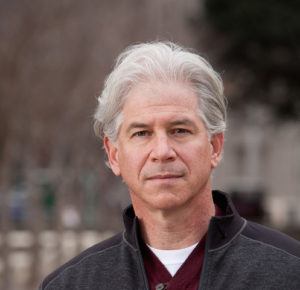Andrew Fastow, former chief financial officer (CFO) of Enron Corp., a now-defunct energy trading company swept up in a massive fraud scandal in the early 2000s, warned a room full of directors and officers (D&O) underwriters that some companies today may be unknowingly following in Enron’s footsteps. He was speaking at the Professional Liability Underwriting Society’s 2017 D&O Symposium held last week at New York’s Marriott Marquis.
“It’s easy to justify unethical, materially misleading behavior by saying, ‘I’m following the rules,'” he said. “Since the rules are very gray in accounting, it gives you a lot of room to maneuver as a CFO or director to get to the answer you want. But if you can justify these transactions because there are rules that allow you to do it, when is it not okay to justify a transaction where the rules allow it? That was a trap I fell into.”
As he spoke, he held two props – a trophy he received for being named CFO Magazine’s CFO of the year in 2000 and his prison identification card, which he received just two years later after Enron’s downfall, which culminated in the firm declaring bankruptcy and Fastow spending six years in federal prison.
“I got both of these for doing the same deals,” he said. “How is it possible to be CFO of the year and go to federal prison doing the same deals? How is it possible to be CFO of the year and commit the greatest fraud in corporate American history doing the same deals?”
He stated that while they were ultimately materially misleading and fraudulent, the deals he carried out while at Enron were initially approved by Enron accountants, outside auditors, Enron’s inside and outside attorneys and the board of directors without any information being withheld.
“If I could sum it up in one word, I would use the word ‘loophole,'” he said. “Companies who underwrite can find a way to get from point A to point B by not necessarily breaking the rules, but by finding loopholes, by rationalizing. Very often, executives and directors don’t see the problem with their decisions – they rationalize.”
Fastow explained that he found it easy to rationalize deals at Enron by believing the transactions would benefit shareholders, save millions of dollars through off-balance sheet financing, increase stock prices and be awarded and recognized.

Source: Professional Liability Underwriting Society (PLUS)
“Finally, I thought, ‘[The deals have] been approved. I don’t have to think about it,'” he said. “That’s how a lot of officers and directors think. The off-balance sheet financing and structured finance going on today is as aggressive, if not more aggressive, than what was going on in the year 2000. People just don’t talk about it and give public awards for it anymore.”
In the span of about four months, however, Fastow saw Enron move from being considered the 7th largest company in the U.S. by revenue to declaring bankruptcy in the wake of a Securities and Exchange Commission (SEC) investigation.
“When I was at Enron, it never even dawned upon me that I might be committing fraud,” he said. “I thought that what I was doing was the right thing. The way I thought about it was everybody gets the rulebooks. Whoever can best exploit those rules and find the loophole gets an advantage. They called me CFO, but my job title should have been ‘chief loophole officer.’ That’s all I did. Everyday. Looking for ways to get around the intent or purpose of the rules.”
After serving his prison sentence for securities fraud, Fastow now speaks and teaches classes on business ethics. He also provides consulting services for short sellers, in which he works to identify questionable items in a company’s financials where the company may be technically complying with rules but is being materially misleading.
This is because it is important to look beyond what is black and white in business ethics, he explained. He added that it is important for business executives to not only ask themselves if they are following the rules, but to also ask themselves if what they are doing is right in spite of the rules.
“Business executives, directors and officers tend to conflate those two questions and think they’re asking the same thing,” he said. “They think, ‘If my attorney is signing off on it, and if my accountant is signing off on it, then it’s okay.’ In corporate America, when everything is going well, people only ask one question: Are you following the rules? When something goes wrong, however, the SEC and plaintiff attorneys come in and ask a different question: Is it right?”
Fastow said the main problem he sees today is that most directors have limited information and are only given a few metrics, such as earnings, credit ratings and information from the CEO.
“They don’t know when they need to get involved,” he said. “Some directors might try to do too much, but most directors do too little because they just don’t have the tools.”
He pointed to one solution as using artificial intelligence software to monitor emails and company communications and detect when tension levels among management spike. He added this can be a useful resource in offering valuable information to directors and significantly lowering risk for underwriters.
“People usually know when there are problems or feel uncomfortable when management is making bad decisions but don’t raise their hands,” he said. “There was a big spike in tension levels at Enron in 1999 following one of the most controversial structured finance deals I did. I thought this deal was genius and so did the Chairman, CEO and directors. None of the top 150 executives at Enron raised their hands and objected to the deal, but they ran this anonymous software against Enron’s database of emails, and it showed tension levels appeared almost as bad as on the day Enron declared bankruptcy. The data showed exactly what the board needed to see. This is the deal that eventually led to the SEC investigation, and the signals were there two years earlier.”
Topics Fraud
Was this article valuable?
Here are more articles you may enjoy.



 4,800 Claims Handled by Unlicensed Adjusters in Florida After Irma, Lawsuit Says
4,800 Claims Handled by Unlicensed Adjusters in Florida After Irma, Lawsuit Says  ‘Dirty Dozen’ Unsafe Employers Putting Workers at Risk
‘Dirty Dozen’ Unsafe Employers Putting Workers at Risk  Insurers Get Green Light to Pay Less Than Billed Charges in Florida PIP Cases
Insurers Get Green Light to Pay Less Than Billed Charges in Florida PIP Cases  South Carolina Ringleader Sentenced to 8 Years for Staged Accidents
South Carolina Ringleader Sentenced to 8 Years for Staged Accidents 


